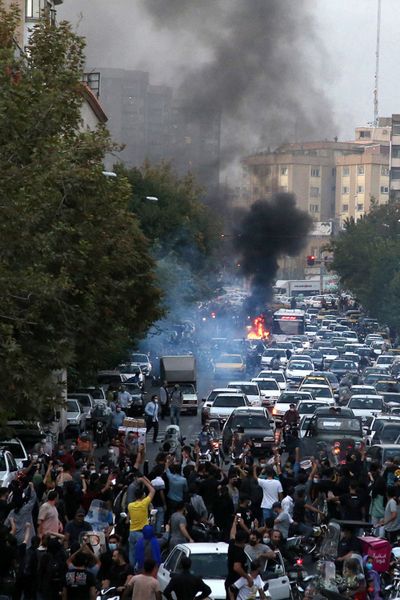6 killed in Iran protests sparked by woman’s death in police custody

The death toll in protests that have roiled towns and cities across Iran rose to six, state media reported, as anger sparked by the case of a young woman who died in police custody spreads.
Two people were killed in the predominantly Kurdish western city of Kermanshah, reports said on Wednesday, while a “police assistant” died and four officers were injured in clashes in the southern city of Shiraz. On Tuesday, state media said three people died in protests in western Kurdistan province, where Mahsa Amini, 22, was buried on Saturday.
She’d been detained by so-called “morality police” for breaking the Islamic Republic’s rules on what women can wear in public. By Tuesday night, protests had spread to multiple cities, according to a government statement, including Karaj, Tabriz, Shiraz, Mashhad, Kish Island, Kerman, Yazd, Esfahan and Hamedan.
Iran’s state media, which is closely aligned with the country’s ruling hard-liners, said “anti-revolutionary” agents and “rioters” were responsible for the deaths and weapons used weren’t the same as those carried by police. Iranian authorities frequently refer to protesters as seditionists, anti-revolutionaries or terrorists, and police are rarely blamed for the deaths of protesters in state media.
The violence has gripped Iran since the weekend and it’s the biggest public backlash against the country’s dress code for women since the 1979 revolution that ushered in the laws. It’s also the most widespread unrest since November 2019 protests over fuel prices.
Those demonstrations were brutally shut down by authorities with rights groups, including London-based Amnesty International, saying more than 320 people were killed by security forces.
On Wednesday, Supreme Leader Ayatollah Ali Khamenei, who’s been singled out in some of the slogans heard in protest footage posted to social media, made a live appearance on state TV but didn’t directly address the unrest. Nor did he appear to give any signals to security forces on how to respond, leaving a question mark over whether the state will crack down on the dissent.
Internet disruptions
After internet restrictions were reported in various cities over the weekend, some hacking groups said on Twitter on Tuesday that they had launched operations targeting government websites.
The Central Bank of Iran said on Wednesday that its website had been subjected to a malicious “distributed denial-of-service attack,” but that the problem had been resolved. However, repeated attempts to load the site and the government’s main web domain from inside and outside Iran failed around noon in London.
It’s common for authorities in Iran to limit or shut down the internet during protests. On Wednesday, Iran’s minister of information and communications technology confirmed that access had been terminated temporarily in some areas but was later running at normal speeds, the semi-official Mehr news agency reported.
The latest unrest coincides with Iranian President Ebrahim Raisi’s first in-person appearance at the United Nations General Assembly in New York. He’s expected to address the summit later on Wednesday but his speech, and any efforts to revive the ailing nuclear talks on the sidelines, are likely to be heavily overshadowed by the protests.